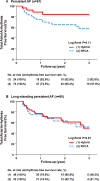Staged hybrid procedure versus radiofrequency catheter ablation in the treatment of atrial fibrillation
- PMID: 30300413
- PMCID: PMC6177159
- DOI: 10.1371/journal.pone.0205431
Staged hybrid procedure versus radiofrequency catheter ablation in the treatment of atrial fibrillation
Abstract
The treatment effect of the hybrid procedure, consisting of a thoracoscopic ablation followed by an endocardial radiofrequency catheter ablation (RFCA), is unclear. A total of 117 ablation-naïve patients who underwent either the staged hybrid procedure (n = 72) or RFCA alone (n = 105) for drug-refractory, non-valvular persistent or long-standing persistent atrial fibrillation (AF) were enrolled. The primary outcome is occurrence of total atrial arrhythmia, defined as a composite of AF, sustained atrial tachycardia (AT), and atypical atrial flutter (AFL) after index procedure. The mean age was 52.7 years. Eighty-four percentage of the patients were male. Patients with prior history of stroke and long-standing persistent AF were more prevalent in the hybrid group than RFCA group. The left atrial volume index was larger in the hybrid group (P<0.001). During 2.1 years of median follow-up, the incidence of total atrial arrhythmia was not different between the two groups (32.5% vs. 35.7%; adjusted hazard ratio: 0.64; 95% confidence interval: 0.36-1.14; P = 0.13). The AF recurrence was significantly lower in the hybrid group than in the RFCA group (29.6% vs. 34.9%; adjusted HR: 0.53; 95% CI: 0.29-0.99; P = 0.046). The hospital stay was longer in the hybrid group than in the RFCA group (11 days vs. 4 days; P<0.001). A staged hybrid procedure may be an alternative choice for drug-refractory persistent AF, but it is no more effective than RFCA alone to eliminate atrial arrhythmias. Considering the long-length of stay and the morbidity, careful consideration should be given in selection of treatment strategy.
Conflict of interest statement
The authors have declared that no competing interests exist.
Figures




Similar articles
-
Staged versus Simultaneous Thoracoscopic Hybrid Ablation for Persistent Atrial Fibrillation Does Not Affect Time to Recurrence of Atrial Arrhythmia.J Cardiovasc Electrophysiol. 2016 Apr;27(4):428-34. doi: 10.1111/jce.12906. Epub 2016 Jan 29. J Cardiovasc Electrophysiol. 2016. PMID: 26725742
-
Comparative Effectiveness of Hybrid Ablation Versus Endocardial Catheter Ablation Alone in Patients With Persistent Atrial Fibrillation.JACC Clin Electrophysiol. 2017 Apr;3(4):341-349. doi: 10.1016/j.jacep.2016.10.010. Epub 2016 Dec 21. JACC Clin Electrophysiol. 2017. PMID: 29759446
-
Midterm outcomes of two-staged hybrid ablation of persistent and long-standing persistent atrial fibrillation using the versapolar epicardial surgical device and subsequent catheter ablation.J Interv Card Electrophysiol. 2017 Nov;50(2):187-194. doi: 10.1007/s10840-017-0286-y. Epub 2017 Sep 18. J Interv Card Electrophysiol. 2017. PMID: 28921386
-
Hybrid thoracoscopic and transvenous catheter ablation of atrial fibrillation.Eur J Cardiothorac Surg. 2014 Mar;45(3):401-7. doi: 10.1093/ejcts/ezt385. Epub 2013 Jul 31. Eur J Cardiothorac Surg. 2014. PMID: 23904136 Review.
-
Advances in catheter ablation: atrial fibrillation ablation in patients with mitral mechanical prosthetic valve.Curr Cardiol Rev. 2012 Nov;8(4):362-7. doi: 10.2174/157340312803760767. Curr Cardiol Rev. 2012. PMID: 23003204 Free PMC article. Review.
Cited by
-
Hybrid convergent ablation versus endocardial catheter ablation for atrial fibrillation: A systematic review and meta-analysis.J Arrhythm. 2021 Nov 2;37(6):1459-1467. doi: 10.1002/joa3.12653. eCollection 2021 Dec. J Arrhythm. 2021. PMID: 34887950 Free PMC article.
-
Deep neuromuscular blockade during radiofrequency catheter ablation under general anesthesia reduces the prevalence of atrial fibrillation recurrence when compared to moderate neuromuscular blockade: A randomized controlled trial.PLoS One. 2025 Jan 21;20(1):e0302952. doi: 10.1371/journal.pone.0302952. eCollection 2025. PLoS One. 2025. PMID: 39836668 Free PMC article. Clinical Trial.
-
Mid term freedom from atrial fibrillation following hybrid ablation, a systematic review and meta analysis.J Cardiothorac Surg. 2023 Apr 19;18(1):155. doi: 10.1186/s13019-023-02189-2. J Cardiothorac Surg. 2023. PMID: 37076929 Free PMC article.
-
Mid-Term Results of Totally Thoracoscopic Ablation in Patients with Recurrent Atrial Fibrillation after Catheter Ablation.Korean J Thorac Cardiovasc Surg. 2020 Oct 5;53(5):270-276. doi: 10.5090/kjtcs.19.059. Korean J Thorac Cardiovasc Surg. 2020. PMID: 32919447 Free PMC article.
-
Total thoracoscopic ablation in patients with atrial fibrillation and left ventricular dysfunction.JTCVS Tech. 2021 Apr 20;8:60-66. doi: 10.1016/j.xjtc.2021.04.006. eCollection 2021 Aug. JTCVS Tech. 2021. PMID: 34401814 Free PMC article.
References
-
- Miyasaka Y, Barnes ME, Gersh BJ, Cha SS, Bailey KR, Abhayaratna WP, et al. Secular trends in incidence of atrial fibrillation in Olmsted County, Minnesota, 1980 to 2000, and implications on the projections for future prevalence. Circulation. 2006; 114:119–25. 10.1161/CIRCULATIONAHA.105.595140 - DOI - PubMed
-
- January CT, Wann LS, Alpert JS, Calkins H, Cigarroa JE, Cleveland JC Jr., et al. 2014 AHA/ACC/HRS guideline for the management of patients with atrial fibrillation: executive summary: a report of the American College of Cardiology/American Heart Association Task Force on practice guidelines and the Heart Rhythm Society. Circulation. 2014; 130:2071–104. 10.1161/CIR.0000000000000040 - DOI - PubMed
Publication types
MeSH terms
LinkOut - more resources
Full Text Sources
Medical

